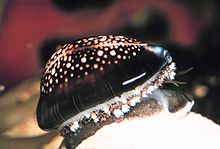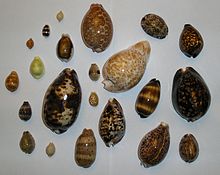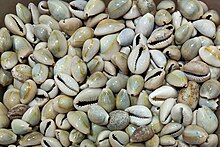| Cowrie Cowry | |
|---|---|

| |
| Cowries are generally seen on rocky areas of the sea bed. | |
| Scientific classification | |
| Domain: | Eukaryota |
| Kingdom: | Animalia |
| Phylum: | Mollusca |
| Class: | Gastropoda |
| Subclass: | Caenogastropoda |
| Order: | Littorinimorpha |
| Superfamily: | Cypraeoidea |
| Family: | Cypraeidae |


Cowrie or cowry (pl. cowries) is the common name for a group of small to large sea snails in the family Cypraeidae.
The term porcelain derives from the old Italian term for the cowrie shell (porcellana) due to their similar appearance.
Cowrie shells have held cultural, economic, and ornamental significance in various cultures. The cowrie was the shell most widely used worldwide as shell money. It is most abundant in the Indian Ocean, and was collected in the Maldive Islands, in Sri Lanka, along the Indian Malabar coast, in Borneo and on other East Indian islands, in Maluku in the Pacific, and in various parts of the African coast from Ras Hafun to Mozambique. Cowrie shell money was important in the trade networks of Africa, South Asia, and East Asia.
In the United States and Mexico, cowrie species inhabit the waters off Central California to Baja California (the chestnut cowrie is the only cowrie species native to the eastern Pacific Ocean off the coast of the United States; further south, off the coast of Mexico, Central America and Peru, Little Deer Cowrie habitat can be found; and further into the Pacific from Central America, the Pacific habitat range of Money Cowrie can be reached) as well as the waters south of the Southeastern United States.
Some species in the family Ovulidae are also often referred to as cowries. In the British Isles the local Trivia species (family Triviidae, species Trivia monacha and Trivia arctica) are sometimes called cowries. The Ovulidae and the Triviidae are other families within Cypraeoidea, the superfamily of cowries and their close relatives.
Etymology
The word cowrie comes from Hindi कौडि (kaudi), which is itself derived from Sanskrit कपर्द (kaparda).
Shell description


The shells of cowries are usually smooth and shiny and more or less egg-shaped. The round side of the shell is called the Dorsal Face, whereas the flat under side is called the Ventral Face, which shows a long, narrow, slit-like opening (aperture), which is often toothed at the edges. The narrower end of the egg-shaped cowrie shell is the anterior end, and the broader end of the shell is called the posterior. The spire of the shell is not visible in the adult shell of most species, but is visible in juveniles, which have a different shape from the adults.
Nearly all cowries have a porcelain-like shine, with some exceptions such as Hawaii's granulated cowrie, Nucleolaria granulata. Many have colorful patterns. Lengths range from 5 mm (0.2 in) for some species up to 19 cm (7.5 in) for the Atlantic deer cowrie, Macrocypraea cervus.
Human use
Monetary use
See also: Shell moneyCowrie shells, especially Monetaria moneta, were used for centuries as currency by native Africans. In his book Marriage and Morals, Bertrand Russell attributed the use of cowrie shells as currency in ancient Egypt to the similarity between shape of the shell and that of female genitalia. Additionally, the money cowrie was almost impossible to counterfeit until the late 19th Century. After the 1500s, however, the shell's use as currency became even more common. Western nations, chiefly through the slave trade, introduced huge numbers of Maldivian cowries in Africa. The Ghanaian cedi was named after cowrie shells. Starting over three thousand years ago, cowrie shells, or copies of the shells, were used as Chinese currency. They were also used as means of exchange in India.
The Classical Chinese character for money (貝) originated as a stylized drawing of a Maldivian cowrie shell. Words and characters concerning money, property or wealth usually have this as a radical. Before the Spring and Autumn period the cowrie was used as a type of trade token awarding access to a feudal lord's resources to a worthy vassal.
Ritual use
The Ojibwe aboriginal people in North America use cowrie shells which are called sacred miigis shells or whiteshells in Midewiwin ceremonies, and the Whiteshell Provincial Park in Manitoba, Canada is named after this type of shell. There is some debate about how the Ojibway traded for or found these shells, so far inland and so far north, very distant from the natural habitat. Oral stories and birch bark scrolls seem to indicate that the shells were found in the ground, or washed up on the shores of lakes or rivers. Finding the cowrie shells so far inland could indicate the previous use of them by an earlier tribe or group in the area, who may have obtained them through an extensive trade network in the ancient past.
In Eastern India, particularly in West Bengal, it is given as a token price for the ferry ride of the departed soul to cross the river "Vaitarani". Cowries are used during cremation. Cowries are also used in the worship of Goddess Laxmi.
In Brazil, as a result of the Atlantic slave trade from Africa, cowrie shells (called búzios) are also used to consult the Orixás divinities and hear their replies.
Cowrie shells were among the devices used for divination by the Kaniyar Panicker astrologers of Kerala, India.
In certain parts of Africa, cowries were prized charms, and they were said to be associated with fecundity, sexual pleasure and good luck. It is also used in the treatment of certain diseases such as rashes and ringworm when it is burnt into ashes.
In Pre-dynastic Egypt and Neolithic Southern Levant, cowrie shells were placed in the graves of young girls. The modified Levantine cowries were discovered ritually arranged around the skull in female burials. During the Bronze Age, cowries became more common as funerary goods, also associated with burials of women and children.
Jewelry
Cowrie shells are also worn as jewelry or otherwise used as ornaments or charms. In Mende culture, cowrie shells are viewed as symbols of womanhood, fertility, birth and wealth. Its underside is supposed, by one modern ethnographic author, to represent a vulva or an eye.
On the Fiji Islands, a shell of the golden cowrie or bulikula, Cypraea aurantium, was drilled at the ends and worn on a string around the neck by chieftains as a badge of rank. The women of Tuvalu use cowrie and other shells in traditional handicrafts.
Games and gambling
Cowrie shells are sometimes used in a way similar to dice, e.g., in board games like Pachisi, Ashta Chamma or in divination (cf. Ifá and the annual customs of Dahomey of Benin). A number of shells (6 or 7 in Pachisi) are thrown, with those landing aperture upwards indicating the actual number rolled.
In Nepal cowries are used for a gambling game, where 16 pieces of cowries are tossed by four different bettors (and sub-bettors under them). This game is usually played at homes and in public during the Hindu festival of Tihar or Deepawali. In the same festival these shells are also worshiped as a symbol of Goddess Lakshmi and wealth.
Other
Large cowrie shells such as that of a Cypraea tigris have been used in Europe in the recent past as a darning egg over which sock heels were stretched. The cowrie's smooth surface allows the needle to be positioned under the cloth more easily.
In the 1940s and 1950s, small cowry shells were used as a teaching aid in infant schools e.g counting, adding, subtracting.
-
 Print from 1845 shows cowrie shells being used as money by an Arab trader.
Print from 1845 shows cowrie shells being used as money by an Arab trader.
-
 Antiquities of Native Americans, particularly of the Georgia tribes (1873)
Antiquities of Native Americans, particularly of the Georgia tribes (1873)
-
 Cowrie shells used as dice, showing a roll of 3
Cowrie shells used as dice, showing a roll of 3
See also
References
- "Home : Oxford English Dictionary". Oed.com. Archived from the original on 10 August 2022. Retrieved 10 August 2022.
- "A Cowry Shell Artifact from Bolsa Chica : An Example of Prehistoric Exchange" (PDF). Pcas.org. Retrieved 10 August 2022.
- "Cowrie". Infoplease.com.
- "Cowri". Dictionary.com. Retrieved 25 September 2013.
- Oxford English Dictionary. Oxford University Press. July 2023. cowrie (n.), Etymology. doi:10.1093/OED/4018863654.
- Russell, Bertrand (1929). Marriage and Morals. H. Liveright. p. 34.
- "The Shell Money of the Slave Trade | Regional history after 1500".
- Jan Hogendorn; Marion Johnson (1986). The Shell Money of the Slave Trade. Cambridge: Cambridge University Press. ISBN 9780521541107. Retrieved 29 April 2015.
- "Money Cowries" Archived 2009-04-05 at the Wayback Machine by Ardis Doolin in Hawaiian Shell News, NSN #306, June 1985
- "Archived copy". Archived from the original on 2021-02-25. Retrieved 2012-05-12.
{{cite web}}: CS1 maint: archived copy as title (link) - Bertsch, Wolfgang (Autumn 2000). "The Use of Maldivian Cowries as Money According to an 18th Century Portuguese Dictionary on World Currencies" (PDF). Oriental Numismatic Society Newsletter. 165: 18 – via Oriental Numismatic Society Archive.
- Pamela Rose Toulouse (2018). Truth and Reconciliation in Canadian Schools. Portage & Main Press. p. 65. ISBN 9781553797463.
- Panikkar, T. K. Gopal (1995) . Malabar and its folk (2nd reprinted ed.). Asian Educational Services. p. 257. ISBN 978-81-206-0170-3.
- Tresidder, Jack (1997). The Hutchinson Dictionary of Symbols. London: Helicon. p. 53. ISBN 1-85986-059-1.
- Ameade, Evans Paul Kwame; Dayah, Barnabas; Kouame, Lovis Nsoua Abina; Edmond, Saavielung Yaganomo; Abraham, Bodong; James, Balansuah Bayuo; Stephen, Gmawurim; Abagna, Linda Adobagna; Adom, Emmanuel (2023-05-19). "Current Uses of Cowries in Traditional Medicine After their Disuse as Currency-A Cross-Sectional Study in Ghana". Advances in Complementary & Alternative Medicine. 7 (4): 727–732.
- Golani, Amir (2014). "Cowrie Shells and their Imitations as Ornamental Amulets in Egypt and the Near East". Polish Archaeology in the Mediterranea: 71–94.
- Kovács 2008: 17
- Radiance from the Waters: Ideals of Feminine Beauty in Mende Art by Sylvia Ardyn Boone. Yale University Press, 1986.
- Hildburgh, W. L. (1942). "Cowrie Shells as Amulets in Europe". Folklore. 53 (4): 178–195. doi:10.1080/0015587X.1942.9717654. JSTOR 1257370.
- Cowries as a badge of rank in Fiji. (archived)
- Tiraa-Passfield, Anna (September 1996). "The uses of shells in traditional Tuvaluan handicrafts" (PDF). SPC Traditional Marine Resource Management and Knowledge Information Bulletin #7. Retrieved 8 February 2014.
- "Tihar". Yeti Trial Adventure. Retrieved 22 October 2014.
Further reading
- Felix Lorenz; Alex Hubert (1999). A Guide to Worldwide Cowries. Conchbooks. ISBN 978-3-925-91925-1.
External links
- [REDACTED] Media related to Cypraeidae at Wikimedia Commons
- Cowrie Genomic Database Project
- Genus Cypraea on Animal Diversity Web
- cowry.org – studying Hawaii's cowries
- Beautifulcowries – a gallery of images of cowries
- "Cowry" . Collier's New Encyclopedia. 1921.
- "Cowry" . Encyclopedia Americana. 1920.
- "miigis" at Wiktionary